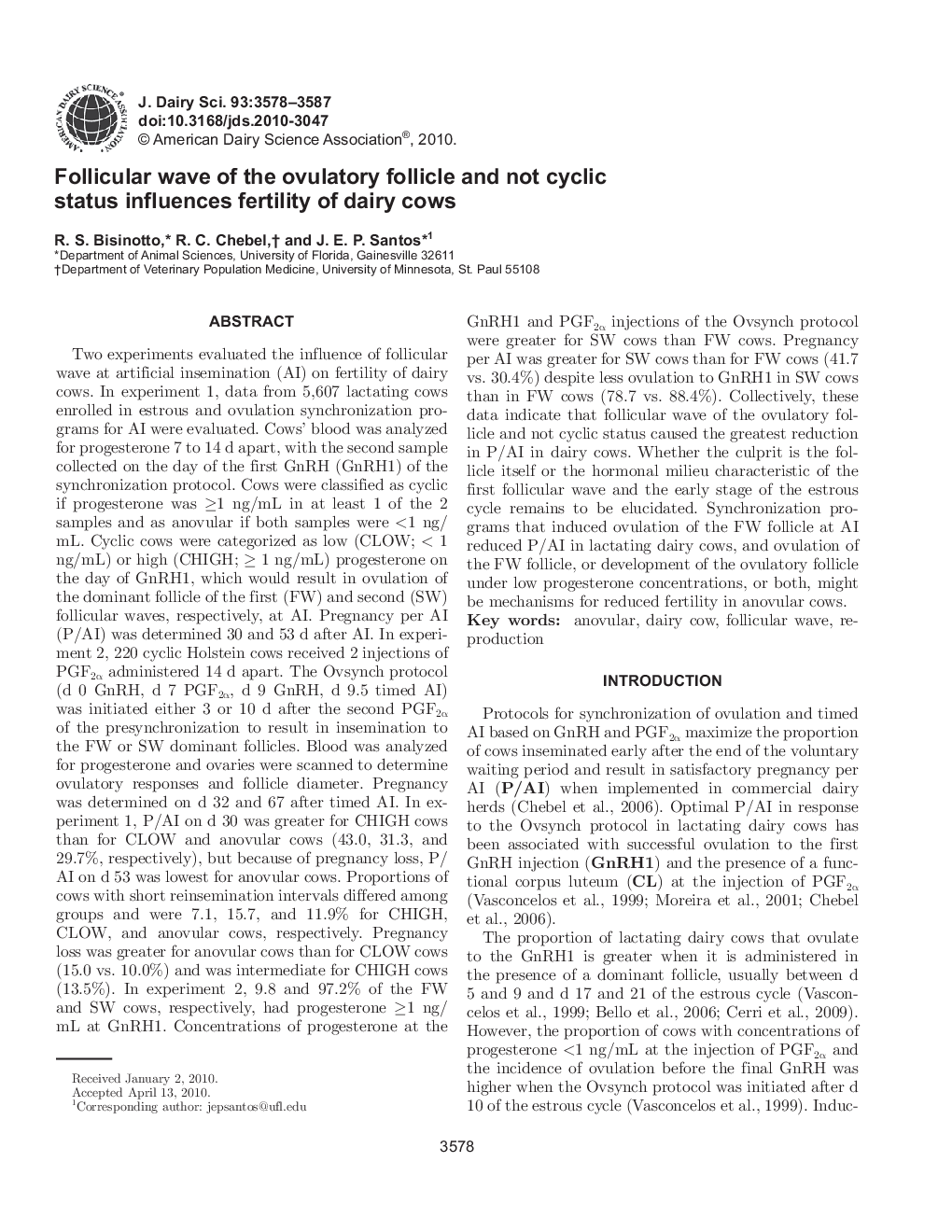| کد مقاله | کد نشریه | سال انتشار | مقاله انگلیسی | نسخه تمام متن |
|---|---|---|---|---|
| 10980882 | 1108073 | 2010 | 10 صفحه PDF | دانلود رایگان |
عنوان انگلیسی مقاله ISI
Follicular wave of the ovulatory follicle and not cyclic status influences fertility of dairy cows
دانلود مقاله + سفارش ترجمه
دانلود مقاله ISI انگلیسی
رایگان برای ایرانیان
موضوعات مرتبط
علوم زیستی و بیوفناوری
علوم کشاورزی و بیولوژیک
علوم دامی و جانورشناسی
پیش نمایش صفحه اول مقاله

چکیده انگلیسی
Two experiments evaluated the influence of follicular wave at artificial insemination (AI) on fertility of dairy cows. In experiment 1, data from 5,607 lactating cows enrolled in estrous and ovulation synchronization programs for AI were evaluated. Cows' blood was analyzed for progesterone 7 to 14 d apart, with the second sample collected on the day of the first GnRH (GnRH1) of the synchronization protocol. Cows were classified as cyclic if progesterone was â¥1 ng/mL in at least 1 of the 2 samples and as anovular if both samples were <1 ng/mL. Cyclic cows were categorized as low (CLOW; < 1 ng/mL) or high (CHIGH; ⥠1 ng/mL) progesterone on the day of GnRH1, which would result in ovulation of the dominant follicle of the first (FW) and second (SW) follicular waves, respectively, at AI. Pregnancy per AI (P/AI) was determined 30 and 53 d after AI. In experiment 2, 220 cyclic Holstein cows received 2 injections of PGF2α administered 14 d apart. The Ovsynch protocol (d 0 GnRH, d 7 PGF2α, d 9 GnRH, d 9.5 timed AI) was initiated either 3 or 10 d after the second PGF2α of the presynchronization to result in insemination to the FW or SW dominant follicles. Blood was analyzed for progesterone and ovaries were scanned to determine ovulatory responses and follicle diameter. Pregnancy was determined on d 32 and 67 after timed AI. In experiment 1, P/AI on d 30 was greater for CHIGH cows than for CLOW and anovular cows (43.0, 31.3, and 29.7%, respectively), but because of pregnancy loss, P/AI on d 53 was lowest for anovular cows. Proportions of cows with short reinsemination intervals differed among groups and were 7.1, 15.7, and 11.9% for CHIGH, CLOW, and anovular cows, respectively. Pregnancy loss was greater for anovular cows than for CLOW cows (15.0 vs. 10.0%) and was intermediate for CHIGH cows (13.5%). In experiment 2, 9.8 and 97.2% of the FW and SW cows, respectively, had progesterone â¥1 ng/mL at GnRH1. Concentrations of progesterone at the GnRH1 and PGF2α injections of the Ovsynch protocol were greater for SW cows than FW cows. Pregnancy per AI was greater for SW cows than for FW cows (41.7 vs. 30.4%) despite less ovulation to GnRH1 in SW cows than in FW cows (78.7 vs. 88.4%). Collectively, these data indicate that follicular wave of the ovulatory follicle and not cyclic status caused the greatest reduction in P/AI in dairy cows. Whether the culprit is the follicle itself or the hormonal milieu characteristic of the first follicular wave and the early stage of the estrous cycle remains to be elucidated. Synchronization programs that induced ovulation of the FW follicle at AI reduced P/AI in lactating dairy cows, and ovulation of the FW follicle, or development of the ovulatory follicle under low progesterone concentrations, or both, might be mechanisms for reduced fertility in anovular cows.
ناشر
Database: Elsevier - ScienceDirect (ساینس دایرکت)
Journal: Journal of Dairy Science - Volume 93, Issue 8, August 2010, Pages 3578-3587
Journal: Journal of Dairy Science - Volume 93, Issue 8, August 2010, Pages 3578-3587
نویسندگان
R.S. Bisinotto, R.C. Chebel, J.E.P. Santos,